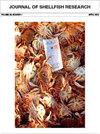Yearling太平洋牡蛎(Crassostrea gigas)的性别决定生长
IF 1
4区 农林科学
Q3 FISHERIES
引用次数: 0
摘要
顺序雌雄同体的杯形牡蛎的性别是由环境和基因决定的。性别也与生长或体型有关,女性平均比同龄男性大。性别决定体型还是体型决定性别还没有得到解决。为了研究生长与性别之间的关系,来自太平洋牡蛎Crassostrea gigas的六个F2家族的1360个标记个体在华盛顿州桑代克湾饲养了第二个夏天;从6月份开始,连续5个月记录了个体活重。在最后一次称重时,性腺组织的显微镜检查显示队列中有四种“性别”,即女性(占队列的43%)、男性(29%)、雌雄同体(2%)和没有配子的性别待定个体(26%)。活重用固定和随机参数拟合各种S形生长曲线(logistic、Gompertz和Richards),以考虑个体差异。最佳拟合曲线表明,直到8月下旬,这一群体的增长才呈指数级增长,当时气温下降,最终体重增加了70%以上。个体活重、生长曲线参数和生长测量值适用于具有家庭和性别分类变量的一般线性模型。在许多此类分析中,家庭与性别的互动具有重要意义。雌性平均比雄性大,并且似乎从优越的生长特征而不是最初的体型中获得了体型优势。在家族内部的生长比较中,雄性要么像雌性,要么像性别待定的较小牡蛎。性别待定的牡蛎可能是“真正的”雄性,它们太小,一岁时就不能成熟,尽管成熟的大小阈值并不明显。基因决定的性别和家族遗传似乎控制着生长。本文章由计算机程序翻译,如有差异,请以英文原文为准。
Sex-Determined Growth of Yearling Pacific Oysters (Crassostrea gigas)
ABSTRACT The sexes of sequentially hermaphroditic cupped oysters are both environmentally and genetically determined. Sex is also associated with growth or body size, females being larger than males of the same age on average. Whether sex determines size or size determines sex has not been resolved. To examine the relationship between growth and sex, 1,360 tagged individuals from six F2 families of Pacific oyster Crassostrea gigas were reared through their second summer in Thorndyke Bay, Washington; individual live weights were recorded for 5 consecutive months, starting in June. At the last weighing, microscopic examination of gonadal tissue revealed four “sexes” in the cohort, females (43% of cohort), males (29%), hermaphrodites (2%), and sex-undetermined individuals with no gametes (26%). Live weights were fit to various sigmoidal growth curves (logistic, Gompertz, and Richards) with fixed and random parameters to account for individual variation. The best fitting curves suggested that growth of the cohort was exponential until late August, when temperatures declined and more than 70% of final weight had been gained. Individual live weights, growth-curve parameters, and growth measures were fit to general linear models with family and sex classification variables. Family-by-sex interaction was significant in many such analyses. Females were larger than males on average and appeared to attain their size advantage from superior growth characteristics rather than from initial size. Males were strikingly either like females or like the smaller sex-undetermined oysters with respect to growth comparisons within family. Sex-undetermined oysters may have been “true” males that were too small to mature as yearlings, though a size-threshold for maturation was not apparent. Genetically determined sex and family genetics appeared to control growth.
求助全文
通过发布文献求助,成功后即可免费获取论文全文。
去求助
来源期刊

Journal of Shellfish Research
生物-海洋与淡水生物学
CiteScore
2.30
自引率
0.00%
发文量
40
审稿时长
6 months
期刊介绍:
Original articles dealing with all aspects of shellfish research will be considered for publication. Manuscripts will be judged by the editors or other competent reviewers, or both, on the basis of originality, content, merit, clarity of presentation, and interpretations.
 求助内容:
求助内容: 应助结果提醒方式:
应助结果提醒方式:


